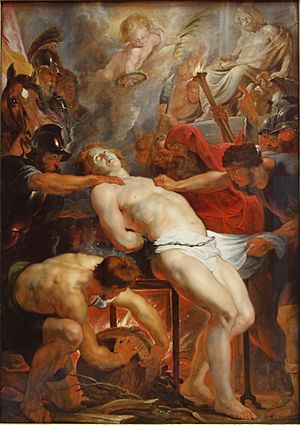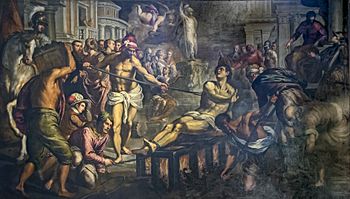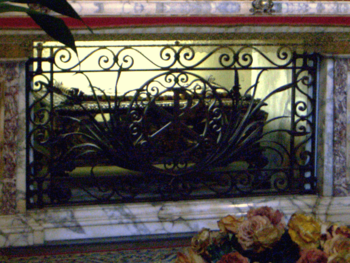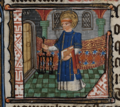Saint Lawrence facts for kids
Quick facts for kids SaintLawrence |
|
|---|---|

Lawrence before Valerian, detail from a fresco by Bl. Fra Angelico, c. 1447–50, Pinacoteca Vaticana
|
|
| Martyr | |
| Born | 31 December AD 225 Huesca or less likely Valencia, Hispania (modern-day Spain) |
| Died | 10 August AD 258 (aged 32) Rome |
| Venerated in | Roman Catholic Church Eastern Orthodoxy Anglican Communion Lutheranism |
| Canonized | Pre-congregation |
| Major shrine | Basilica di San Lorenzo fuori le Mura in Rome |
| Feast | 10 August |
| Attributes | Usually holding a gridiron and wearing a dalmatic |
| Patronage | Rome, Grosseto, Rotterdam (Netherlands), Huesca (Spain), San Lawrenz, Gozo and Birgu (Malta), Barangay San Lorenzo San Pablo (Philippines), Canada, Colombo City, comedians, archivists, librarians, students, miners, tanners, chefs, Balagtas, Bulacan, Balangiga, Eastern Samar, Mexico, Pampanga, San Lorenzo Diakono Chapel, Mexico, Pampanga, roasters, poor, firefighters |
Saint Lawrence (also spelled Laurence) was an important leader in the early Christian Church in Rome. He was one of seven deacons who helped Pope Sixtus II. Deacons were special helpers who managed the Church's money and cared for people in need.
Lawrence lived during a time when the Roman Empire was not friendly to Christians. The Roman Emperor Valerian ordered that Christians be persecuted in 258 AD. Lawrence was one of many Christians who bravely stood up for their beliefs and became a martyr.
Contents
The Life of Saint Lawrence
Lawrence was likely born on December 31, 225 AD, in Huesca, a town in what is now Spain. His parents are believed to be Orentius and Patientia.
Lawrence met the man who would become Pope Sixtus II in a city called Caesaraugusta (modern-day Zaragoza). They traveled together to Rome. When Sixtus became Pope in 257 AD, he made Lawrence a deacon. Lawrence was only 22 years old at the time.
Lawrence Becomes Archdeacon
Later, Lawrence was given an even more important role: "archdeacon of Rome." This meant he was the chief among the seven deacons. He was trusted with the Church's money and valuable items. His job also included giving help and support to the poor and needy.
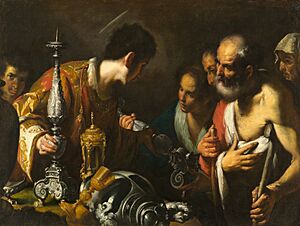
Persecution of Christians
In 258 AD, Emperor Valerian issued a new law. This law said that all Christian bishops, priests, and deacons should be put to death. Soon after, Pope Sixtus II was captured and executed on August 6, 258 AD.
After the Pope's death, the Roman prefect (a high-ranking official) demanded that Lawrence hand over the Church's riches. Lawrence asked for three days to gather these treasures. He quickly worked to give away as much of the Church's property as possible to the poor. This way, the Roman authorities could not take it.
The True Treasures of the Church
On the third day, Lawrence appeared before the prefect. When asked to show the Church's treasures, he brought forward the city's poor, sick, and suffering people. He bravely declared, "Here are the treasures of the church. You see, the church is truly rich, far richer than your emperor!"
The Martyrdom of Saint Lawrence
Lawrence's bold statement made the prefect very angry. The prefect ordered a large gridiron (a metal grate used for cooking) to be heated with hot coals. Lawrence was then placed on it.
Legend says that after suffering for a long time, Lawrence cheerfully said, "I'm well done on this side. Turn me over!" Because of this story, Saint Lawrence is known as the patron saint of cooks, chefs, and even comedians.
Lawrence was sentenced in a place called San Lorenzo in Miranda. He was imprisoned in San Lorenzo in Fonte, where he even baptized other prisoners. He was martyred in San Lorenzo in Panisperna and later buried in San Lorenzo fuori le Mura.
Emperor Constantine I later built a small chapel to honor Lawrence. This chapel eventually became the large Basilica di San Lorenzo fuori le Mura. Another church, the Minor Basilica of San Lorenzo in Panisperna, was built where he was martyred. The actual gridiron used in his martyrdom is said to be kept in the Minor Basilica of San Lorenzo in Lucina.
Churches in Rome Honoring Saint Lawrence
Many churches in Rome are dedicated to Saint Lawrence. Six of these churches are built on places connected to his life and martyrdom:
- Minor Basilica of St Lawrence in Damaso: Where he served as a deacon.
- Minor Basilica of St Mary in Domnica alla Navicella: Where he often gave help to the poor.
- Annexed Church of St Lawrence in Miranda: Where he was sentenced.
- Annexed Church of St Lawrence in Fonte: Where he was imprisoned and baptized prisoners.
- Church of St Lawrence in Panisperna: The site of his martyrdom.
- Papal Minor Basilica of St Lawrence outside the Walls: Where he was buried.
There are also three other important churches in Rome named after him, though they are not directly linked to his life:
- Minor Basilica of St Lawrence in Lucina: This church holds what are believed to be parts of the gridiron and chains used in his martyrdom.
- Church of St. Lawrence in Palatio ad Sancta Sanctorum: A very old Papal chapel that once held many important relics.
- Church of St Lawrence in Piscibus: Located near St. Peter's Basilica.
Miracles Associated with Saint Lawrence
Stories of miracles linked to Saint Lawrence have been told for centuries. One early story comes from Gregory of Tours (538–594 AD).
The Miracle of the Bread
A priest named Fr. Sanctulus was rebuilding a church dedicated to St. Lawrence. He had many workers but ran out of food for them. He prayed to Saint Lawrence for help. When he looked in his basket, he found a fresh loaf of bread. It seemed too small, but he began to serve it to the workers. The bread miraculously multiplied, feeding his workers for ten days!
The Liquefying Blood
In Amaseno, Italy, there is a special container called an ampulla. It holds relics of Lawrence, including some of his blood, a piece of his flesh, and ashes. Tradition says that every year on his feast day (August 10), the blood in the ampulla miraculously turns from solid to liquid. It then becomes solid again the next day.
Veneration of Saint Lawrence
Saint Lawrence is one of the most respected saints in the Roman Catholic Church. Stories about his death were known very early, by the 4th century. His feast day on August 10 is an important celebration in the Church calendar. He is also one of the saints mentioned in the "Roman Canon" during Holy Mass.
Lawrence is especially honored in Rome, where he is considered the third patron saint after St. Peter and St. Paul. The area around his tomb, the Basilica di San Lorenzo fuori le Mura, is even named "Quartiere San Lorenzo" after him.
The Tears of Saint Lawrence
The Perseid Meteor Shower happens every year around mid-August, close to Saint Lawrence's feast day. Because of this, some people call the meteor shower the "Tears of St Lawrence."
People ask for his help as the patron saint of librarians, archivists, comedians, cooks, and tanners. He is also the patron saint of Ampleforth Abbey in England.
On his feast day, a special container holding what is believed to be his burnt head is displayed in St. Peter's Basilica for people to honor.
Saint Lawrence in the Anglican Church
In the Anglican Communion, Saint Lawrence is also highly regarded. His feast day is on August 10 in their calendar. He is remembered as "S Laurence, Archdeacon of Rome and Martyr." Many Anglican churches in England and Australia are named after him. The charitable group, Brotherhood of St Laurence, also carries his name.
Legacy of Saint Lawrence
Saint Lawrence's story highlights the important role of deacons in serving the poor. His bravery and dedication show the deep meaning of helping others.

Many places around the world are named after Saint Lawrence. These include churches, schools, towns, and even geographic features. For example, San Lorenzo del Escorial, a large monastery in Spain, was built by King Philip II of Spain. Its design is said to look like the gridiron used in Lawrence's martyrdom.
Two universities are named after him: St. Lawrence University in New York, United States, and St. Lawrence University in Kampala, Uganda. There is also St. Lawrence High School, Kolkata in Kolkata, India.
Saint Lawrence in Canada
Saint Lawrence is the patron saint of Canada. In 1535, French explorer Jacques Cartier arrived at a large river estuary on Saint Lawrence's feast day. He named it the Gulf of St. Lawrence. The river flowing into it became the St. Lawrence River. Many places in Québec and the Maritime Provinces are named after this important waterway, like the Laurentian mountains and Saint Lawrence Boulevard in Montreal.
In Toronto, Ontario, the historic St. Lawrence neighborhood is well-known for the large St. Lawrence Market. The Laurentian Mountains also gave their name to the Canadian Shield, a vast rocky area.
Other Mentions
In Switzerland, Saint Lawrence is shown on the coat of arms of the city of Bülach, holding a gridiron.
The rescue of miners in the 2010 Copiapó mining accident in Chile was called Operacíon San Lorenzo. This was because Lawrence is the patron saint of miners.
In Freemasonry, there is a special group called the Order of St. Lawrence the Martyr. Its ceremonies are based on Lawrence's story.
In Bernalillo, New Mexico, people celebrate Saint Lawrence for three days. This tradition began after Spanish settlers made a promise during the Pueblo Revolt in 1692. The celebrations include special dances. An image of the saint is kept by a local family, and a vigil and feast are held from August 9–11. This is one of the oldest dancing processions in the New World.
Patronage
- Against Fire
- Against Lumbago
- Archives and Archivists
- Armouries and Armourers
- Barbecues
- Brewers
- Butchers
- Comedians
- Cooks, chefs and restaurant owners
- Cutlers
- Deacons
- Glaziers and stained glass workers
- Laundry workers
- Libraries and librarians
- Miners
- Paupers and poor people
- Seminarians
- Students
- Tanners
- Viticulturists, wine makers and wine sellers
- Abano Terme, Italy
- Alba, Italy
- Angrogna, Italy
- Bernalillo, New Mexico, USA
- Berzo Demo, Italy
- Berzo Inferiore, Italy
- Brissogne, Italy
- Cabella Ligure, Italy
- Camino, Italy
- Canada
- Cavatore, Italy
- Chambave, Italy
- Denice, Italy
- Esbonderup, Denmark
- Folgaria, Italy
- Gamalero, Italy
- Gross Gartach, Germany
- Győrszemere, Hungary
- Huesca, Spain
- Il-Birgu, Malta
- Ilaya, Dapitan City, Philippines
- Limbazi, Latvia
- Lund, Sweden
- Montevarchi, Italy
- Mortara, Italy
- Naurod, Germany
- Oldenburg, Lower Saxony, Germany
- Pontinvrea, Italy
- Rome
- Rotterdam
- San Lawrenz, Malta
- Santena, Italy
- Scala, Italy
- Seravezza, Italy
- Sri Lanka
- Tivoli, Italy
- Zagarolo, Italy
Images for kids
-
A statue of St Lawrence overlooking the river named after him, the Saint Lawrence River
-
Lawrence statue in St Lawrence Deacon & Martyr Parish Church, Balagtas, Bulacan, Philippines
-
St Lawrence holding the gridiron, by the Master of Messkirch, c. 1535–40
-
St Lawrence pictured on the astronomical clock in Lund Cathedral, Sweden
-
St Lawrence depicted in a 14th-century book of hours
See Also
 In Spanish: Lorenzo de Roma para niños
In Spanish: Lorenzo de Roma para niños
- Saint Lawrence, patron saint archive
- Saint Lawrence (disambiguation)
- San Lorenzo (disambiguation)
- St. Laurence's Church (disambiguation)


